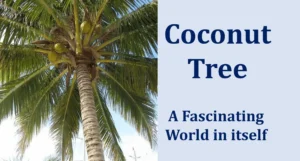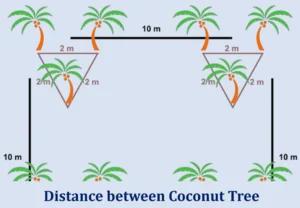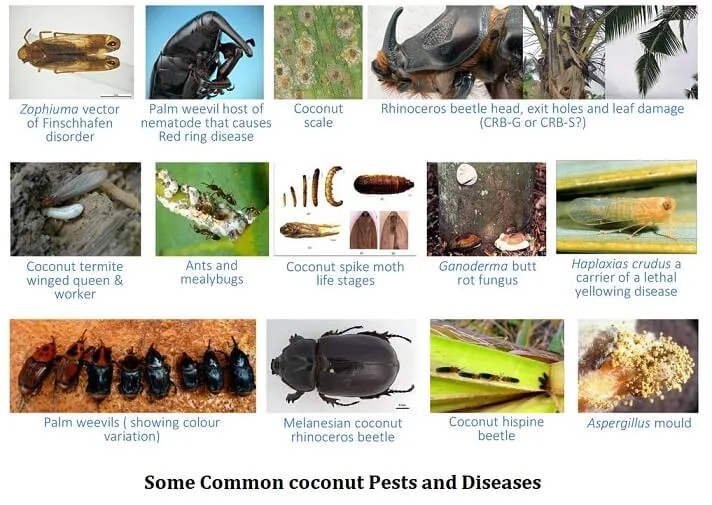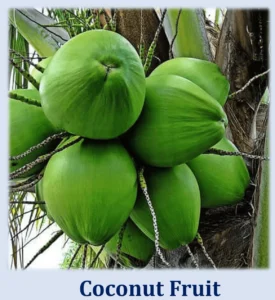
Growing tall under the bright blue sky, the coconut tree, also called “Cocos nucifera,” is like a symbol of a beautiful tropical place. The coconut tree isn’t just pretty to look at near the sea but it also helps the people who live there a lot. Through this blog post I’ll discover for all my readers various aspects associated with the coconut tree. It will illustrate aspects such as how are they grown, its importance to the nature and the impact they have on people and society.
The Origin of the word Coconut
The word “Cocos nucifera” which I have mentioned in the very first line of this blog is the scientific name of the coconut tree. It reveals some of its distinguishing qualities of this tree. “Cocos” is believed to come from the Spanish word( some also consider it to be a Portuguese word), meaning “monkey-faced” or “eerie-faced,” possibly because the three germinating pores on its nut resemble a monkey’s face. “Nucifera” comes from Latin, signifying a nut-bearing plant, derived from “fero” meaning “I bear” and “nux-nucis” meaning “nut.”
The Coconut’s Fascinating Journey
Coconuts is believed to have a fascinating story about its origin. They are believed to have originated in Southeast Asia and then spread throughout the Pacific, either carried by migrating Indonesians and Polynesians or drifting on ocean currents. The fruits of the coconut tree can be used in different using the different components.
This amazing tree is also known as “Kalpavriksha” in India. It means “tree of abundance” in Malayalam. Its fruit, called as “Lakshmi Phal,” is adored in Indian social and religious events. Also, the fact that people use coconut all over India shows how everyone in the country is connected and united. It might also hint at the idea that long ago, people moved from places where coconuts grew or that coconuts were grown in many different parts of India before.
Global Presence of Coconut tree
Not only these coconut palms are found across the entire tropical regions but can even thrive in areas with mild frosts. While the Asia-Pacific area accounts for 90% of global coconut exports, coconut goods contribute to the economy of many poor countries.
Conditions required for the growth of Coconut Tree
Like any other tree or plant Coconut trees also require specific conditions for optimal growth. Here are the key conditions required for the growth of coconut trees:
Climate
Tropical Climate: Coconut trees thrive in tropical regions with consistently warm temperatures. They cannot tolerate frost or extended periods of cold weather.
Temperature: The ideal temperature range for coconut tree growth is between 80°F (27°C) and 95°F (35°C). They can withstand brief temperature drops but not prolonged cold spells.
Rainfall
Adequate Rainfall: Coconut trees require a consistent supply of moisture, ideally receiving between 60 to 200 inches (150 to 500 cm) of annual rainfall. They can tolerate short dry periods but need regular watering during prolonged droughts.
Well-Distributed Rainfall: Coconut trees prefer evenly distributed rainfall throughout the year rather than distinct wet and dry seasons. However, they can adapt to seasonal variations in some regions.
Soil
Sandy Loam Soil: Coconut trees thrive in well-draining, sandy loam soils with good water-holding capacity. They do not tolerate waterlogged or saline soils.
pH Level: The ideal soil pH for coconut trees is slightly acidic to neutral, typically between 5.5 and 7.0.
Sunlight
Coconut trees require full sun exposure to grow and produce fruit. They should receive at least 8 hours of direct sunlight each day.
Watering
Young coconut trees need regular and consistent watering until they establish a strong root system. Mature trees can withstand occasional dry spells but should be watered during extended droughts.
Wind Protection
Coconut trees are pretty tough and can handle windy conditions, but when really powerful storms or hurricanes come along, they can get hurt or even knocked over. Planting them in sheltered locations or providing windbreaks can help protect them.
Planting
Spacing: Coconut trees should be spaced adequately to allow for their large canopies and root systems. Typically, they are planted 30 to 50 feet (between 9 to 15 meters, most economical being 10 meters) apart.

Proper Depth: When planting coconut trees, ensure that the nut is buried at the right depth in the soil, with the top exposed.
Maintenance
Pruning: Prune dead or damaged fronds regularly to promote healthy growth and prevent diseases.
Fertilization: Apply appropriate fertilizers containing essential nutrients, particularly nitrogen, potassium, and magnesium, to support growth and fruit production.
Pest and Disease Control
Monitor for common coconut pests and diseases, such as the coconut rhinoceros beetle and lethal yellowing disease, and take preventive measures as needed.

Patience
Coconut trees take several years to become mature and start producing fruit. It can take anywhere from 5 to 10 years or more for a coconut tree to bear its first fruit.
All these conditions are very important for the successful growth of a coconut tree and coconut production. It’s important to note that coconut cultivation may vary slightly depending on the specific coconut variety and local environmental conditions.
Features of the Coconut Tree and Coconut
This long-lived tree boasts a single trunk that can reach heights of 20-30 meters (approximately 65-98 feet). Its smooth, gray bark bears ringed scars left by fallen leaf bases. Its trunk is straight and slender and its long, feathery fronds wave gently in the breeze. This tree is famous for its coconuts, the large fruits it produces. It may live for up to a century and produce 50 to 100 coconuts every year.

Coconuts are long-lasting fruit. They stay fresh for several months and therefore it becomes ideal for global transportation. To pick the perfect coconut, look for one that feels heavier than it looks and shake it to hear the water sloshing inside. Avoid coconuts with cracks, dampness, or mold.
Opening a coconut can be a challenge but using a screwdriver and a rubber mallet or rock is more effective than a hammer. Don’t waste the precious coconut water; it’s delicious and nutritious.
Coconut Trees: Maintaining Ecological Balance
- Erosion Control: Coastal regions often face the threat of erosion due to harsh tides and storms. They have extensive roots. These roots aid in the binding and stabilization of the soil by keeping it from being washed away. Further it helps in maintaining the integrity of coastlines.
- Biodiversity Support: Coconut trees provide a habitat for various species of birds and insects. The entire tree is a biodiversity in itself as its fronds are used by birds to build their nest. Whereas the insects like bees and butterflies pollinate their flowers and contribute to local biodiversity.
- Saline Tolerance: Coconut trees are remarkable for their ability to thrive in saline conditions. They have the capacity to tolerate the salty sea water. This ability of coconut tree makes them the most suitable for coastal areas with high amount of Saline water.
Cultural Significance
The coconut tree holds a special place in the cultures of many tropical regions:
- The Tree of Life: Each and every part of this tree has significance whether it be medicinal, ecological or economical. Therefore, it is termed to be a tree of life for the people growing them.
- Religious and Spiritual Symbolism: In Hinduism, the coconut is considered an auspicious offering to deities. It is utilized in rites and ceremonies in various cultures to represent purity and fertility.
- Traditional Medicine: Traditional medical systems such as Ayurveda believe that different elements of the coconut tree, particularly the coconut water and oil, have therapeutic characteristics and are used to cure a variety of maladies.
Versatile Uses of the Coconut Tree
The coconut tree, as previously indicated, is known as the “Kalpa Vriksha” because of its great flexibility. It offers a diverse range of items with a substantial influence on our lives.:
- Nutritious Coconuts: The coconut’s white flesh, known as “copra,” is rich in essential nutrients like vitamins, minerals, and healthy fats. It provides both hydration and energy.
- Refreshing Coconut Water: Coconut water, found inside young coconuts, is a natural rehydration drink packed with electrolytes.
- Multipurpose Coconut Oil: Coconut oil is a kitchen staple and a beauty secret. Besides cooking, people use it for various purposes which include skin and hair treatment and maintenance. It is very useful in keeping the skin and hair healthy.
- The Creamy Coconut Milk: It forms an important ingredient of the tropical Cuisines. It is believed by the locals that it enhances the flavor of the soups, curries, desert and drinks.
- Strong Coir Fiber: The coconut’s husk provides coir, a robust fiber used to make ropes, mats, and even gardening products.
- Delicate Palm Hearts: The tender inner shoot, known as “palm heart,” is a culinary delicacy used in salads and various dishes.
- Traditional Uses: Besides food and drink, coconut trees offer materials for housing, thatching, furniture, mats, clothing and more. Even soap, lubricants, explosives, and margarine can trace their origins back to coconuts.
Sustainable Practices and Challenges
Apart from number of benefits of this tree as discussed above there are some challenges associated with it. Some of the major drawbacks are the infections that might destroy the trees. To make sure coconut trees keep giving us good things for a long time, we need to use sustainable methods like organic farming and planting other crops alongside them.
In Conclusion
The coconut tree is a gift from nature to humans. Not only it beautifies our environments but also provides food, shelter and employment to many people all around the world. From its strong roots in the sandy soil to its tall leaves swaying in the wind, the coconut tree is something truly amazing in our natural world. It is our duty to take care of this incredible plant and protect it. We must also make sure it stays around for the generation yet to come.
